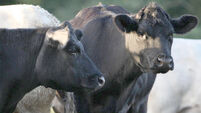Early detection the key to treatment of redwater

Always pay attention to the one animal that does not stand up as you approach, or the animal on its own.
Reclamation and reseeding of fields with rushes, gorse, scrub and bracken will reduce redwater.
Animal Health Ireland has updated redwater disease information on its www.animalhealthireland.ie website.
Redwater can be a very severe, life-threatening cattle disease, and must be treated promptly.
Caused by Babesia divergens, a single-celled parasite, it is transmitted by the common tick seen on livestock.
Farmers should aim to prevent animals being bitten by ticks, by keeping pasture short and well managed.
When an infected tick bites cattle, the parasite is injected into the blood. It rapidly divides in susceptible cattle, rupturing the red blood cells.
The animal becomes anaemic, and the ability of its blood to carry oxygen is reduced. Haemoglobin is released and excreted by the kidneys, giving urine its characteristic colour (can vary from black to red).
If the anaemia is severe, the blood is very thin, the heart sounds much louder than normal, and can be heard when you get within a few feet of the animal.
>>From when the animal is bitten to showing signs of disease can be up to three weeks. Careful and frequent observation is the best way to detect early stages of disease.
Regular checking of cattle recently introduced to pasture is essential.
Subtle changes to normal behaviour are often the first sign that something is wrong. Always pay attention to the one animal that does not stand up as you approach, or the animal on its own, or standing in shelter when the others are grazing. Check urine and faeces if possible.
Early on, signs may be limited. However, animals can die quite quickly. Contact your vet immediately if you suspect redwater.
Early signs include animals staying away from the herd on their own, reduced appetite, hollow left flank, high temperature, frothy red-brownish urine (nearly black in severe cases), diarrhoea (often “pipestem diarrhoea”, passed in a thin jet).
Later (and often terminal) signs include weakness, staggering, unable to stand, changes in the colour of skin and mucous membranes (the gums, under the eyelids) from pink to abnormally pale or yellowish, sub-normal temperature, normal urine colour, constipation, death.
>>Call your vet immediately. Red urine can occur in other conditions, and early diagnosis and veterinary treatment are key to survival.
Even with prompt treatment, there is significant mortality. Animals without previous exposure to the parasite, cows (particularly in advanced pregnancy), and poorly nourished animals tend to be more severely affected. Even if they survive, pregnant heifers/cows may abort.
An animal in the advanced stage of the disease may die of heart failure if stressed. Severely anaemic animals may behave unpredictably or become dangerously aggressive, because of the effect on brain function of lowered blood oxygen.
>>Aim to prevent tick bites.
Rushy ground, gorse, scrub and bracken are ideal habitats for ticks. Reclamation and re-seeding will help reduce tick habitat, and will reduce redwater. But ticks can persist in the margins and headlands of reclaimed fields, and sporadic cases may still occur.
Prevent under-grazing and overgrowth, clear scrub (furze, ferns and rushes) from grazing land.
Keep susceptible cattle out of tick-infested areas, especially in the peaks of tick activity in spring and autumn.
If you have to graze areas known to be infested with ticks, try to use home-bred stock that were exposed to these areas as calves in their first six months. Try to ensure any bought-in animals are younger than six months, and are exposed to ticks and redwater before their innate immunity wears off. Or buy in animals known to have grazed tick-infested areas.
Liaise with your vet on use of preventive products. Flumethrin and Amitraz are licensed for control of ticks in cattle. Even after treatment, animals should be monitored closely in high risk periods.
When the effect of these wears off, the animal’s susceptibility to being bitten and infected is the same as for untreated animals.
Injecting with imidocarb diproprionate at twice the treatment dose will limit parasite multiplication for about four weeks. Ideally, cattle should be allowed to become infected while being fully protected by the drug, so that they can develop a natural immunity. But there is no way to tell which animals become immune and which remain susceptible. Care should be taken to observe the imidocarb dipropionate withdrawal period, 213 days in meat and 21 days for milk.
Both of these methods need to be judiciously timed to ensure coverage through the tick season. Cases of redwater may occur, but are generally fewer and milder. Cattle at pasture still need checking at least daily, and twice daily in the peak tick seasons.
>>If new to an area, discuss the redwater history of the area with the local vet or other farmers.
Infected ticks can survive and persist even if there are no cattle in the area.
Three factors determine when and where redwater will occur — tick habitat, weather, and immunity or resistance to infection.
Apart from the few days each year that ticks spend attached to an animal, they live at the base of the pasture sward. The risk of redwater is greatest where densely vegetated or under-grazed rough pasture provides an ideal tick habitat. Well managed and closely grazed swards hold far fewer ticks.
When the tick leaves the vegetation to seek a host, it is very vulnerable to environmental conditions — particularly to drying out. Ticks tend to avoid seeking hosts in hot, dry periods. Traditionally, the highest risk periods are in late spring, early summer (April, May), and in autumn (August-October). However, redwater can occur throughout the year if climatic conditions are suitable.
An unusual feature of redwater is that cattle under about six months tend not to develop clinical disease, and exhibit some natural resistance. This explains why many closed herds in heavily infested areas rarely get clinical redwater. However, animals older than six to nine months are highly susceptible if introduced from a non-endemic area into the endemic area.
>>No, but it is impossible to tell which do.










